Affiliate links on Android Authority may earn us a commission. Learn more.
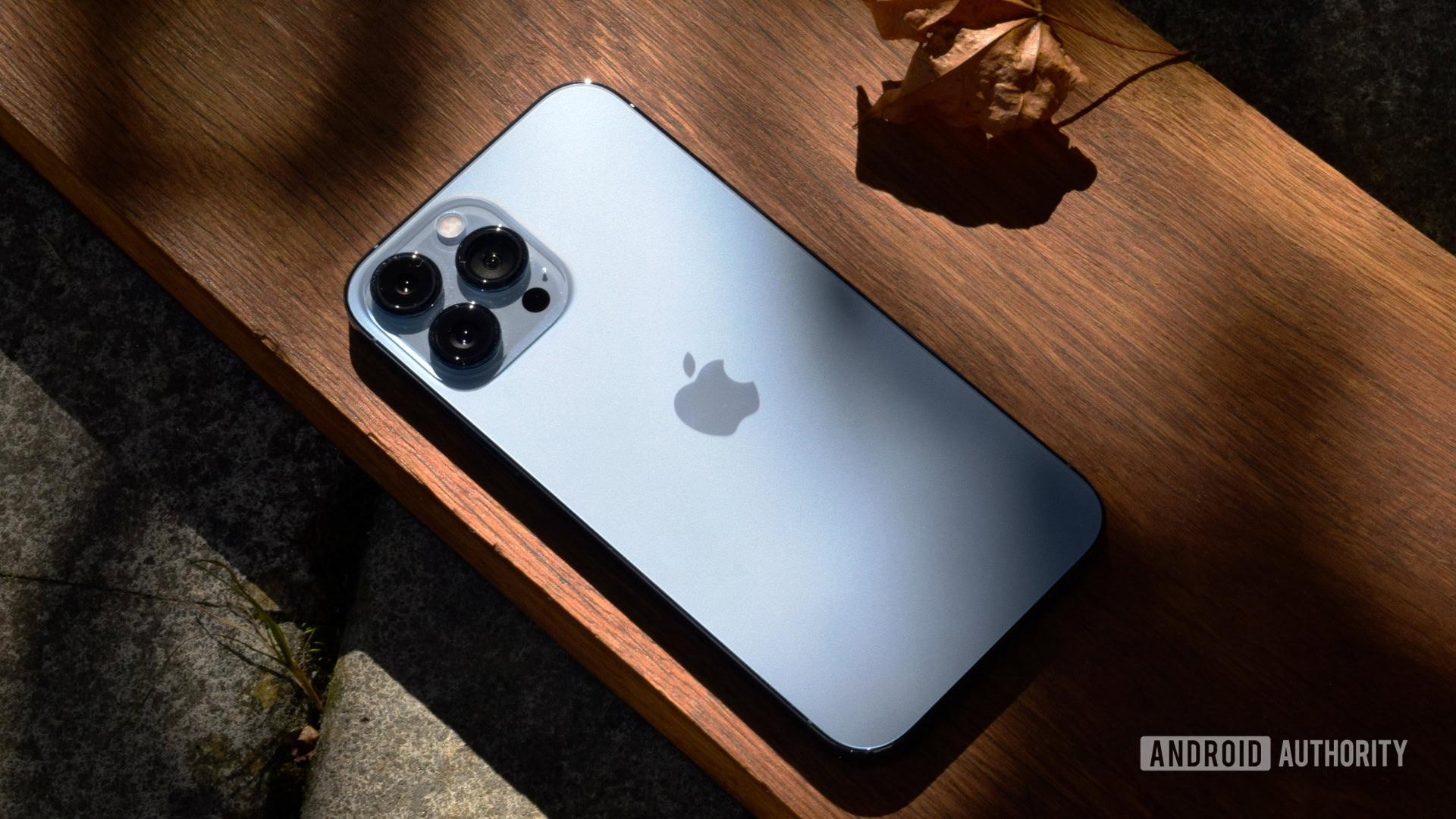


Apple iPhone 13 Pro Max
What we like
What we don't like
Our scores

Apple iPhone 13 Pro Max
The end of the year always seems to bring the usual flurry of high-end smartphones ahead of next-gen flagships, and 2021’s final quarter was no exception. Those looking for one of the best non-Android phones in the business immediately turned to the Apple iPhone 13 Pro Max.
While the design may have barely changed since 2019’s iPhone 11 series, Apple continues to pour its latest hardware and software innovations into the Pro Max. The iPhone 13 Pro Max also looked particularly promising for videographers, thanks to its all-new camera and display capabilities. So come and check out what the latest iteration has to offer in our Apple iPhone 13 Pro Max review.
What you need to know about the Apple iPhone 13 Pro Max
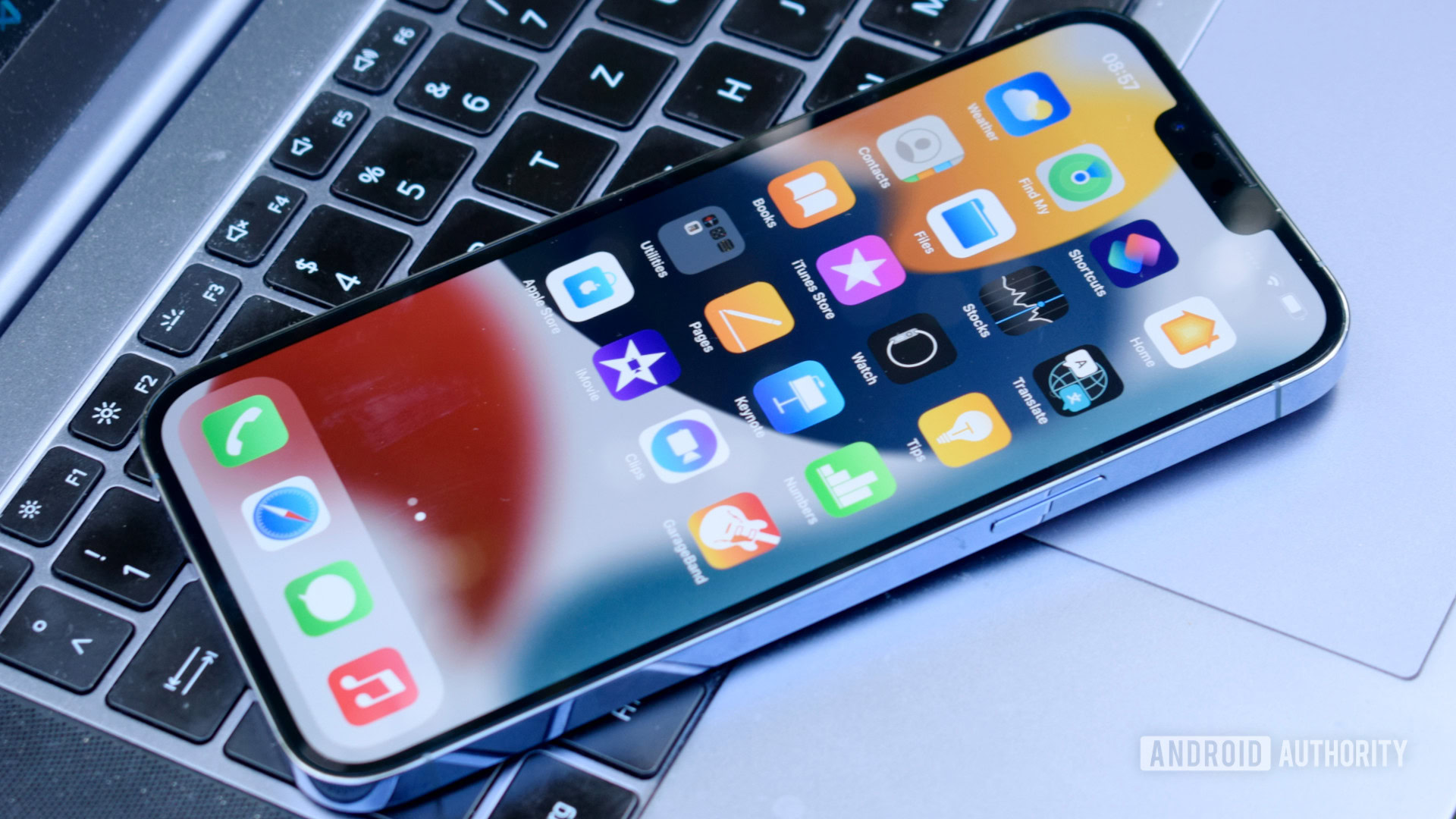
- Apple iPhone 13 Pro Max (128GB): $1,099 / £1,049 / €1,249 / Rs.129,900
- Apple iPhone 13 Pro Max (256GB): $1,199 / £1,149 / €1,369 / Rs.139,900
- Apple iPhone 13 Pro Max (512GB): $1,399 / £1,349 / €1,599 / Rs.159,900
- Apple iPhone 13 Pro Max (1TB): $1,599 / £1,549 / €1,829 / Rs.179,900
Launched in late 2021, the iPhone 13 Pro Max is Apple’s premium smartphone offering, sitting at the top of the iPhone 13 range. It’s accompanied by the regular iPhone 13, iPhone 13 Mini, and iPhone 13 Pro models.
This time around, both the Pro and Pro Max are showcases for the company’s best mobile technology, including an upgraded processor, 5G improvements, and new camera capabilities. The handsets also sport a new 120Hz ProMotion display, MagSafe compatibility, an IP68 rating, a smaller display notch, and an improved front-facing speaker setup. The only changes between the Pro and Pro Max are the screen size and battery capacity, along with a $100 price difference.
Continuing a recent controversy, there’s no charger in the box, just a Lightning to USB-C cable. Apple is happy to sell you an adapter for $19 or a wireless MagSafe charger for $39. Alternatively, any USB Power Delivery 2.0 plug rated for 20W or more will charge the iPhone as quickly as Apple’s official products.
Between the four memory configurations and four color options (Graphite, Gold, Silver, and the all-new Sierra Blue — the one we tested — and Alpine Green, which launched later in 2022), there are technically 16 different iPhone 13 Pro Max variants to choose from. Apple has upped the smallest memory configuration to 128GB on this outing and storage tops out at 1TB for those who haul around large on-device media libraries. There’s also 6GB of RAM on board, up from 4GB previously, so more memory all around. Apple has also increased the size of the battery in the hopes of extending the phone’s battery life.
The iPhone 13 Pro Max hit stores alongside the wider iPhone 13 family on September 30, 2021. It’s available to buy from Apple, Amazon, and many, many other third-party retailers around the world.
Design: Copy, paste
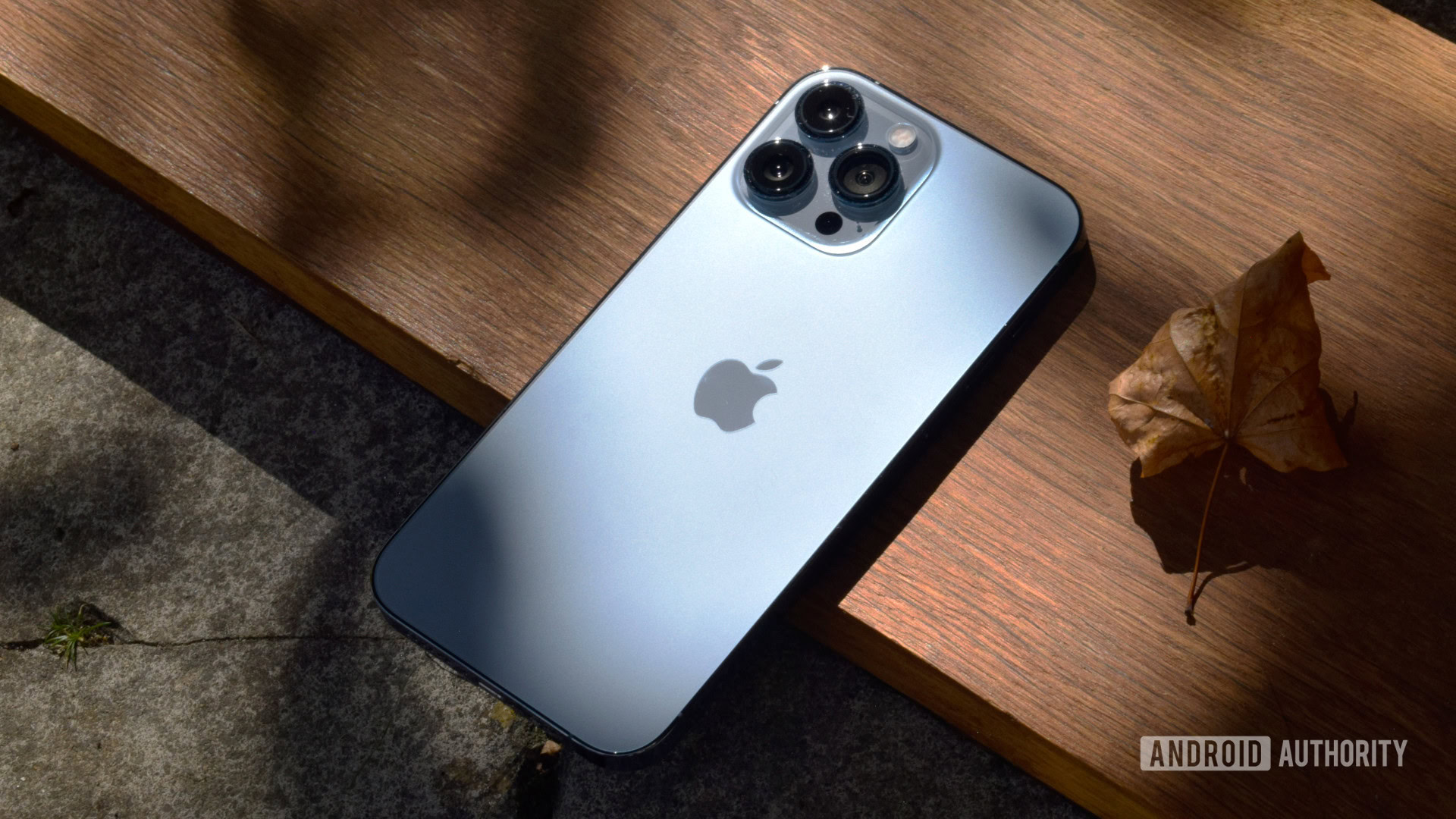
- Ceramic Shield and Gorilla Glass, stainless-steel
- 160.8 x 78.1 x 7.65mm
- 240g
- Face ID, 3D depth sensor
- IP68 water and dust resistance
- 20% smaller notch
- Stereo speakers
- Graphite, Gold, Silver, and Sierra Blue colors
If you’ve seen a recent iPhone, you’ve seen the iPhone 13 Pro Max. Apple has changed very little about the series’ classic design, and why fix what isn’t broken? However, the iPhone 13 Pro Max is 12g heavier and 0.15mm thicker than the previous model. It’s a big, bulky, unwieldy phone.
The sheer size of the 6.7-inch display isn’t helped by the handset’s straight edges, relatively chunky bezels, and 19.5:9 aspect ratio display. It’s pretty hard to fit this thing in your pocket and difficult to use in one hand. The iPhone is broad compared to the 20:9 aspect ratio of Samsung’s flagships and felt downright corpulent coming after my time testing Sony’s elegant and slimline 21:9 Xperia 1 III. Still, these are all familiar complaints that won’t deter Apple fans from the company’s latest and greatest. Perhaps we’ll see bigger design changes with the iPhone 14 Pro Max.
The iPhone’s now-familiar unattractive notch is, thankfully, about 20% smaller than the iPhone 12 Pro Max yet still houses all the necessary Face ID hardware in lieu of a fingerprint scanner. It’s another dated aspect of the iPhone’s design compared to modern punch-hole panels, in-display fingerprint scanners, and the early days of under-display front cameras. However, Face ID is powerful, fast, secure, and deeply integrated enough in Apple’s ecosystem to stick around.
See also: Our guide to all the phone accessories you’ll ever need
The iPhone 13 Pro Max packs an IP68 rating against dust and water resistance and a marginally better-sounding set of front-facing Dolby Atmos speakers compared to the iPhone 12 Pro range. The speakers sound good as far as phones go, although the presentation still isn’t crystal clear at the low end. The stereo presentation is good but easily ruined by tilting the phone even slightly off-axis. If you’re into wireless audio, Apple doesn’t support fancy Bluetooth codecs like aptX and LDAC. But AAC will still serve most headphones well enough.
There’s a familiar Lightning port for charging and data on the bottom and support for MagSafe/Qi wireless charging on the back. It’s infuriating that Apple stubbornly sticks with Lightning for its iPhones while its latest iPads have embraced the more ubiquitous USB-C. It’s not just another adapter cable to carry around, the iPhone won’t place nicely with many USB-C accessories out there either unless you carry a dongle around. There’s no headphone jack, of course — Apple abandoned that several generations ago. Apple’s signature power button, volume rocker, and mute slider are framed in a lovely stainless steel chassis.
It's infuriating that Apple stubbornly sticks with Lightning for its iPhones.
Rounding out the design is Gorilla Glass protection on the front and back, paired with a scratch-resistant Ceramic Shield display with an oleophobic coating. Apple and Corning are hesitant to talk specifics on the grade of Gorilla Glass, but early testing has shown it’s a near equivalent to Gorilla Glass Victus.
Apple also has a new color option, Sierra Blue, the model I’ve been using. It’s a nice option for those who fancy a splash more style than Graphite or Silver without the gaudiness of Gold. Sierra Blue is more conservative and professional-looking than the iPhone 12 Pro Max’s Pacific Blue, and as such I’m a fan. Clearly, someone at Apple still has an eye for design.
Read more: We can’t help it, MagSafe is awesome
Display: High refresh balderdash
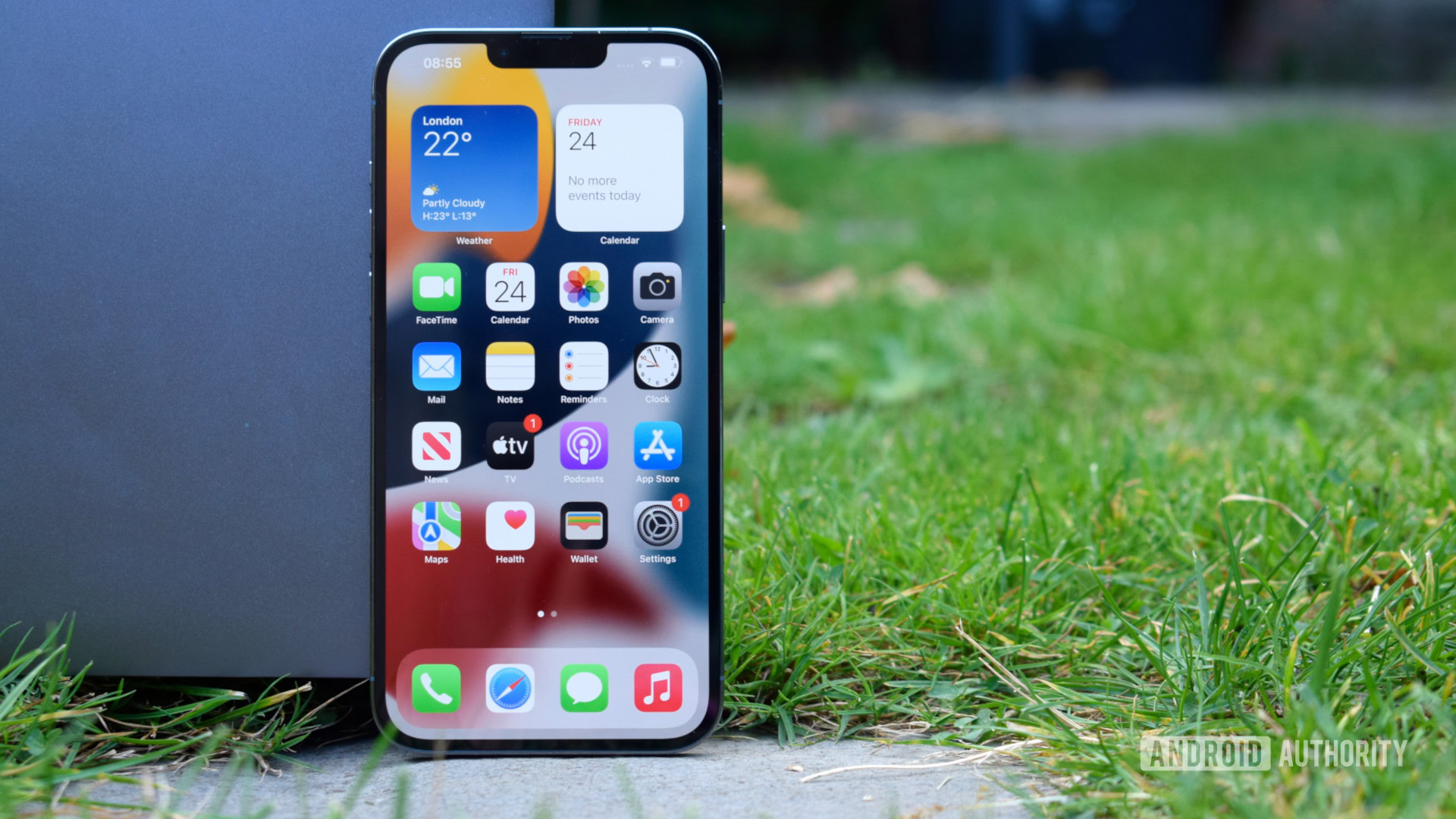
- 6.7-inch OLED with LTPO
- 2,778 x 1,284 resolution
- 458 pixels per inch
- ~19.5:9 aspect ratio, 120Hz variable refresh rate
Reading past Apple’s typical buzzword and marketing gibberish, the iPhone 13 Pro Max finally joins the trend in high refresh rate displays. Sporting a “ProMotion” 120Hz LTPO-backed panel, animations and scrolling appear that bit smoother and more luxurious than before. As this is an adaptive refresh rate, the panel doesn’t run at 120Hz all the time to save battery life. However, at the moment this has the knock-on effect that 120Hz is actually seldom used.
For example, Safari only clocked in at 60Hz while rival Android phones are capable of hitting 120Hz in Chrome. The iPhone’s low power mode knocks this down to 30Hz. Apple notes that third-party developers have to enable 120Hz support, so some apps are still not making the most of the phone’s display. But it’s only a matter of time before they do, though. However, it should be noted this could affect the phone’s battery life if more apps start using the mode.
This is the only blemish on an otherwise exceptional display. The updated panel boasts impressive peak brightness, contrast ratio, and color gamut specs and looks every bit as good as the numbers suggest. Colors are bright and vivid, HDR content looks great, details are crisp, and the panel’s 1,000 nits of peak brightness ensures outdoor viewing is completely glare-free.
For completeness, I ran the display through our display test suite. I turned True Tone off to disable the phone’s ambient brightness and color adaption control. Despite advertising a Wide Color P3 color space, the display appears to default to sRGB out of the box. But that comes with an incredibly accurate DeltaE of just 0.82 and a max error of 1.63. HDR content with a P3 colorspace doesn’t fare quite as well, as the panel can’t quite display the full-color gamut. Even so, it’s still a very good display.
Performance: Doesn’t get better than this
- Apple A15 Bionic
- Five-core Apple GPU
- 6GB RAM
- 128, 256, 512GB, or 1TB storage
As we’ve come to expect from Apple, the iPhone 13 Pro Max’s latest A15 Bionic processor is blazingly fast. The chipset packs more than enough performance for day-to-day apps and games. The addition of a fifth GPU core over previous iPhone silicon ensures that the most demanding mobile titles run without frame rate stutters while cranking up all the bells and whistles. This extra performance doesn’t come with too much of a cost to battery life either (more on that later).
The iPhone 13 Pro Max has the fastest smartphone chip around.
When it comes to benchmarks, the A15 Bionic led the pack at launch and continues to rank at the top of GPU tests even today. Compared to its predecessor, the iPhone 12 Pro and the A14 Bionic, we’re looking at about an 8% single-core CPU improvement and a 22% uplift in multi-core scenarios. Graphics-wise, the addition of a new GPU core in the Pro and Pro Max models boosts performance between 10% and 25% depending on the test.
In cross-platform testing at launch, the Apple iPhone 13 Pro Max topped our charts for Geekbench 5 and 3DMark by quite some margin, powering past the fastest Android phones on the market at the time. During its launch presentation, Apple noted that its latest handset was 50% more powerful than “the leading competition,” i.e. Android phones. That’s not quite the full picture, but single-core CPU and graphics performance certainly meet and even exceed that metric, at least in these benchmarks.
The bottom line: The iPhone 13 Pro Max had the fastest smartphone chip around in late 2021 and even with the release of Snapdragon 8 Gen 1 phones, it’s still extremely competitive.
Apple is also packing sub-6GHz and mmWave 5G capabilities into the iPhone 13 Pro Max, depending on your region. The US is the only market with mmWave on board, so, in theory, can hit the fastest speeds, providing you’re in one of the few areas with mmWave available. The new model brings 5G carrier aggregation and a selection of new bands to improve regional support. Again though, these vary by country, so be aware if you plan to import an iPhone from a different region. It also supports eSIM technology, providing your carrier is supported.
However, you won’t find all the networking bells and whistles here. The phone lacks the cutting-edge Bluetooth 5.2 and Wi-Fi 6E standards you’ll find on high-end smartphones like Samsung’s Galaxy S22 Ultra. While still niche, we’d expect a phone commanding such a high price to be more futureproof in this regard.
The iPhone 13 Pro Max scores another notch higher than its predecessor in terms of both general performance and 5G — although it’s certainly not a revolution in either regard compared to the iPhone 12 Pro Max.
Battery: Two day’s worth
- 4,374mAh battery
- 20W USB Power Delivery 2.0 wired charging
- 15W MagSafe wireless charging
- 7.5W Qi wireless charging
With a bigger battery on board — 4,373mAh vs 3,687mAh last generation — Apple is looking to dispel the iPhone’s reputation for causing battery anxiety. It’s definitely mission accomplished, at least as far as the iPhone 13 Pro Max is concerned.
Of course, battery life varies depending on your use case. In my experience, basic web browsing, social media, and occasional video watching resulted in over nine hours of screen-on time. That’s almost certainly enough for most users to go through two entire days on a single charge. It’s very difficult to run this phone down and battery life easily rivals and often exceeds what you’ll get from Android smartphones.
See also: The best charging accessories
The handset is an efficient gamer too, chugging down just under 30% battery during a two-hour gaming session. Extrapolating, the Pro Max’s decent-sized battery offers around six hours of gaming time, fantastic for entertainment on long trips.
Two full days of battery life is one of the best in the business. It's a shame the charging speed is not.
The iPhone 13 Pro Max offers a selection of charging options. The fastest is 27W wired charging via USB Power Delivery adapters, although this lags notably behind other premium smartphones, including the Galaxy S22 Ultra. As the low wattage implies, the iPhone 13 Pro Max takes over a couple of hours to fully charge, although it reaches a very usable 50% in under an hour. For wireless power enthusiasts, the handset sports 15W MagSafe and 7.5W Qi charging options. While nice to have, these are definitely slower than wired charging and won’t have you back on your feet so quickly.
Camera: A creative toolkit
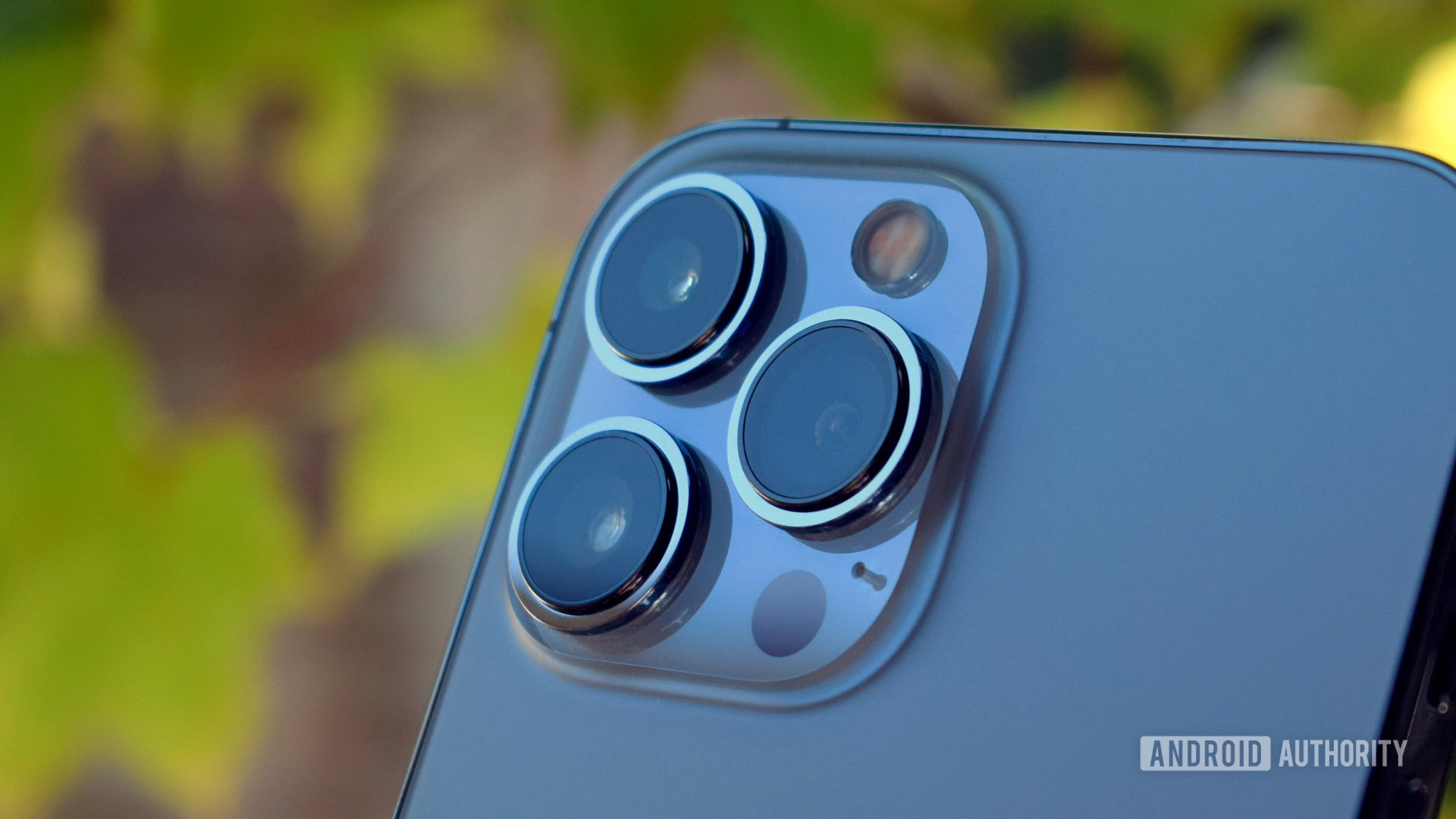
- 12MP, dual pixel PDAF, dual OIS, ƒ/1.5, 1.9µm pixel size
- 12MP ultrawide, 120-degree field of view, five-element lens, PDAF, ƒ/1.8
- 12MP telephoto, ƒ/2.8, dual OIS, six-element lens, 3x optical zoom
- 12MP front camera, ƒ/2.2
- TrueDepth 3D sensor (depth and biometrics)
- 4K HDR 60fps and 1080p 120fps slo-mo video recording
We expect cutting-edge photography from the iPhone and the Pro Max boasts the best technology that Apple has to offer. Overall I’m pleased with the phone’s camera capabilities, particularly when it comes to colors, white balance, and details. Apple’s camera now asks you to pick from Photographic Styles on the first open, which offer customizable contrast and tint to your pictures. There are four presets, Vibrant, Rich Contrast, Warm, and Cool. I’ve left it on Standard for the samples you’ll see below.
Check out: The best camera phones you can get
Apple prefers a warmer white point than other camera phones but it’s not an issue as such and the camera otherwise balances colors very well. It’s hard to take a bad picture with this phone. However, I’ve used a lot of very good camera phones and the iPhone 13 Pro Max isn’t flawless, particularly when it comes to exposure.
For instance, Apple promises improved HDR photography capabilities for this generation, but my experience is a mixed bag, yet again. Apple’s HDR sensor and software technology has fallen behind the Android competition in recent generations. It’s tough to say if the iPhone 13 Pro Max is much better than the 12 Pro Max. It’s perhaps more consistent than its predecessor but the phone is still more prone to highlight clipping and underexposure than Samsung’s Galaxy S21 Ultra and other smartphones I’ve tested.
Likewise, Apple boasts improvements to low light capabilities this generation. The iPhone 12 Pro Max, assisted by Night Mode, was passable in this regard, and the iPhone 13 Pro Max is a little better but certainly not game-changing. Generally, low-light shots come out less noisy than the competition (such as the S21 Ultra below) and have a fraction more color and exposure than the previous iPhone. But there’s not a huge amount between the two without pixel peeping. Night mode helps out further and the handset can pull out a lot of color and detail from an otherwise drastically underlit scene. That being said, even with a wider aperture the ultrawide and, to a lesser extent, the telephoto lenses are not quite as usable in the dark, although Night Mode definitely helps if you have steady hands.
An oddity that Apple seems to have introduced is automatic camera lens switching to ensure the best focus. For example, 3x won’t always use the telephoto lens if the environment is too dark or the subject too close. While this is a good idea in principle, this means that the phone regularly resorts to the inferior ultrawide camera for macro and won’t engage the 3x telephoto at closer and medium ranges. Samsung’s Galaxy S21 Ultra has a similar feature to help focus the main camera but prompts the user with a toggle to turn it on and off. The iPhone 13 Pro Max could use a similar option.
Still, the upgraded 3x telephoto lens takes some decent snaps at medium range. The phone’s usable zoom range extends out to around 5x but beyond that the side effects of digital zoom are apparent. Zoom image quality is marginally improved from the iPhone 13 Pro Max’s 2.5x telephoto lens, mostly thanks to lower noise, but the iPhone 13 Pro Max is still missing the long-range capabilities of some rival phones. The ultrawide lens provides a huge step back from the main sensor, with colors and exposure that almost perfectly match the main sensor. Kudos to Apple, as color and exposure matching is a problem we see on a lot of other phones. Overall, the iPhone 13 Pro Max is a consistently good shooter from 0.5x out to 5x, enough flexibility for all but the extremely demanding photographer.
It's virtually impossible to take a bad picture with this phone.
Outdoor selfies are similarly solid, although Apple’s skin tones are a little on the warm side. The inclusion of depth-sensing data allows the iPhone 13 Pro Max to apply accurate and great-looking bokeh blur to your selfies. Fine stray hairs still cause a few edge detection issues but this is a common problem for software blur and you won’t notice unless you examine your pictures really closely. Unfortunately, the selfie camera fairs less well indoors with lower light levels. There’s a notable level of grain and face textures begin to smudge. Granted, it still holds up better than some front-facing cameras but it’s an issue we’d hoped Apple would address this generation.
One new feature Apple has included with the iPhone 13 Pro Max is a new Cinematic video mode. The option brings software bokeh to video capture with the added gimmick of autofocusing on faces looking at the camera. This works as advertised but can be finicky with multiple faces in the scene. And although this mode is targeted at creators, it doesn’t offer any control over frame rate or resolution, which you can find in the regular video mode.
How does it compare? Our mega 2021 camera shootout
ProRes video, Apple’s lossless video compression format for editing, was missing at launch but is now available. Although the 128GB model will be limited to 1080p ProRes due to its high data consumption. Overall, Apple’s videography remains one of the best in the business and the iPhone 13 Pro Max adds new tools for those who like to dabble in mobile creativity, but serious movie makers will still want some more professional kit.
All these features are wrapped up in Apple’s traditional camera app. It’s still a mostly standard affair that will feel familiar no matter what phone you’re coming from. However, the growing range of modes and icons has added to the app’s complexity. It’s not quite as easy or quick as it once was to find the option you’re after.
Despite Apple’s talk about a larger sensor for better light capture, marginally longer zoom, and improved HDR capabilities, I’ve not detected a huge amount of difference between the iPhone 13 Pro Max and the iPhone 12 Pro Max so far. The iPhone remains a very solid shooter but there’s nothing revolutionary that should cause you to rush out and upgrade. You can check out the full-resolution camera samples in this Google Drive folder.
Software: Faithfully Apple
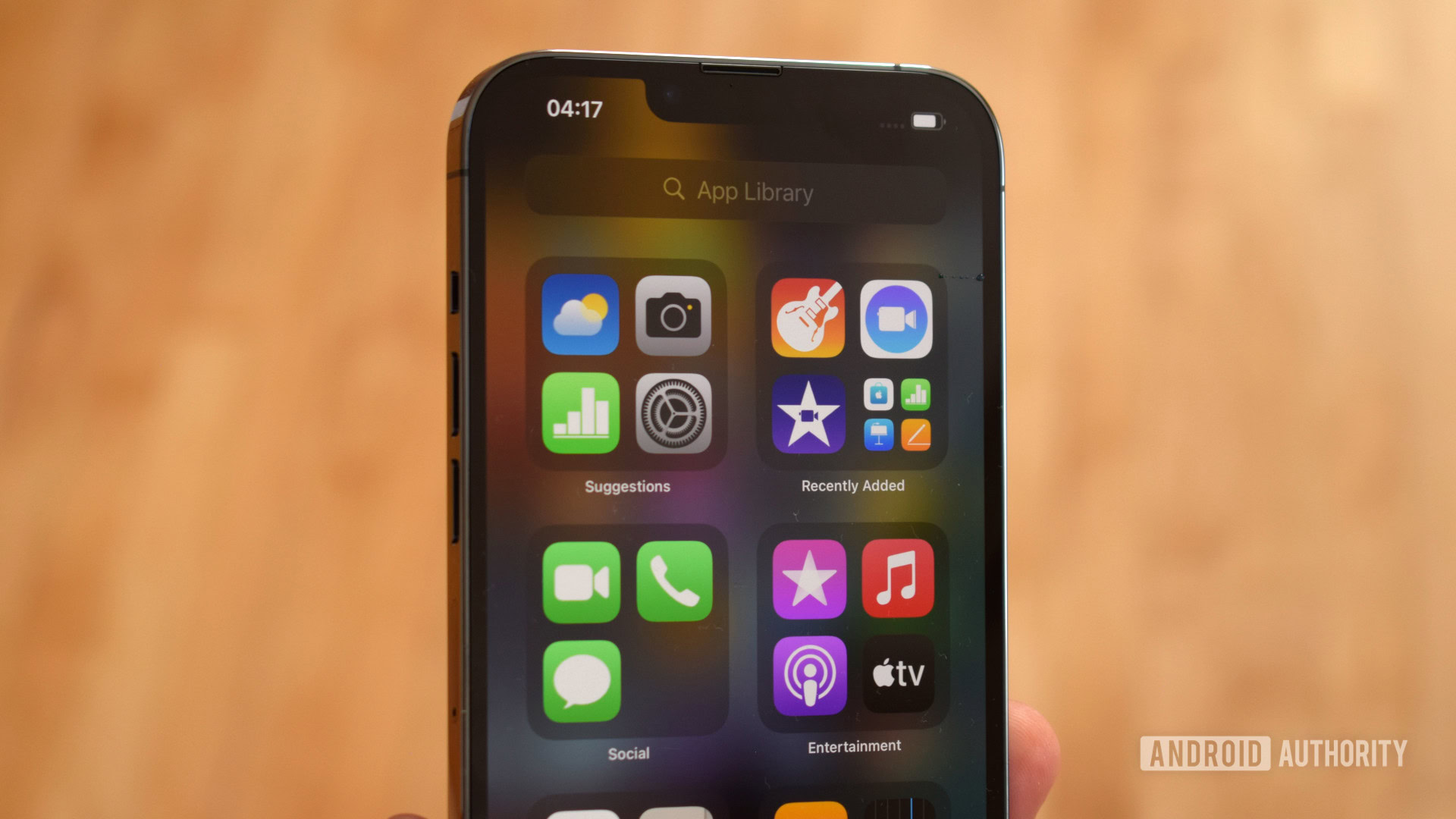
- iOS 15
- Updated to iOS 15.3.1
I don’t spend more than a few months with iOS in any given year but each time I return I’m equal parts impressed and infuriated with Apple’s mobile operating system and ecosystem. It’s no different with iOS 15.
If you’re big into Apple’s extended product ecosystem then its software setup is second to none. AirPods, Apple Watches, and iPads connect seamlessly and it’s effortless to transfer data between devices thanks to iCloud and AirDrop. Apple’s first-party apps are beautifully presented and expertly functional — although Apple is overly keen to push its Music, News, and TV subscription services onto you. So brace yourself for free-trial notifications for Apple TV Plus and Apple Arcade — the latter an Apple exclusive with access to some truly excellent mobile games.
iOS 15 offers everything you’d want from a modern mobile OS. Stackable widgets, introduced in iOS 14, are a particularly neat idea that builds on the classic Android formula. Merging news and weather into a single swipeable widget, for example, is great for seeing everything at a quick glance without cluttering up the home screen. Likewise, the App Library automatically sorts your apps, making them easier to find than eyeballing a cluttered home screen. Again, this isn’t a new feature, it was also introduced with the iPhone 12 series.
Instead, the move to iOS 15 is more about specific improvements than overhauling the traditional iOS experience. Focus Mode, for example, builds on the classic Do Not Disturb formula, allowing you to filter calls and notifications by contacts, apps, and the time of day or your location. Once set up, it’s an extremely powerful tool to help you manage when and to whom you’re available and limit notification distractions.
Other upgrades include various Maps improvements, Portrait Mode and spatial audio for Facetime, photo collages in iMessage, more user-friendly Safari navigation controls, and a redesigned weather app, to name some of the bigger changes. As such, the day-to-day iOS experience feels pretty similar to previous years.
Expect the iPhone 13 Pro Max to be supported with iOS updates for a long, long time.
Instead, it’s specific apps that look and feel a bit different compared to iOS 14. Given that the iPhone 12 series can already upgrade to iOS 15, the new software isn’t worth running out to buy a new phone for by itself. That’s a credit to Apple’s speedy and long-term update policy, which continues to put most Android manufacturers to shame. Case in point: the iPhone 6S is eligible for an iOS 15 update. Expect the iPhone 13 Pro Max to be supported for a long, long time.
If you’re coming from an Android phone, iOS 15 is instantly usable but still features a number of design oddities. The lack of a universal back button and the one sometimes located in the upper left makes navigation less intuitive than it should be. Why settings for something as simple as camera gridlines are tucked away under camera in the universal settings app rather than in the camera app itself is even more bizarre. I’ll never understand why iOS allows for some settings to be kept so far out of reach while some apps, such as Chrome, are much more self-contained. Equally, the App Library to the right-most screen is more time-consuming to access than Android’s home button or swipe up equivalents. Siri, while perpetually improving, isn’t quite as flexible or powerful as Google Assistant either, particularly when it comes to broader smart home ecosystems.
Read more: All the key iOS 15 features and how they compare to Android
Of course, for regular iPhone users, these complaints may sound petty. But I’m equally exasperated by Android skins that pollute the OS with obfusticating layers of menus and options. iOS feels like it falls into a similar trap, failing to keep things as intuitive and simple as they could be. That being said, iOS 15’s new features add up and it’s still a mostly slick and highly functional mobile operating system, if not verging on a little bloated.
As of August 2022, our iPhone 13 Pro Max had received the iOS 15.6 update, which includes various enhancements, bug fixes, and security updates. These include the ability to restart a live sports game as well as pause, rewind, or fast-forward it — learn more here. This is likely the last update to iOS 15 we’ll see, as Apple will release iOS 16 with the launch of the iPhone 14 series, which will likely happen in September.
Apple iPhone 13 Pro Max specs
| iPhone 13 Pro Max | |
|---|---|
Display | 6.7-inch Super Retina XDR OLED 2,778 x 1,284 resolution ProMotion 120Hz HDR, True Tone Wide color (P3) 2,000,000:1 contrast ratio 1,000 nits max brightness (typical); 1,200 nits max brightness (HDR) Ceramic Shield front |
Processor | Apple A15 Bionic |
Storage | 128 / 256 / 512GB /1TB |
Battery | Qi wireless charging up to 7.5W Up to 50% charge in around 30 minutes with 20W adapter or higher (sold separately) MagSafe: Wireless charging up to 15W Magnet array Alignment magnet Accessory Identification NFC Magnetometer |
Cameras | Rear: -Wide-angle 12MP, ƒ/1.5, dual OIS, 7-element lens, 100% Focus Pixels, Night Mode -Ultra-wide 12MP, ƒ/1.8, 120° field of view, 5-element lens, lens correction, Night Mode -Telephoto 12MP, ƒ/2.8, dual OIS, 6-element lens 3x optical zoom in, 2x optical zoom out, 6x optical zoom range, digital zoom up to 15x, Deep Fusion, Smart HDR 3, Apple ProRAW Video: HDR video with Dolby Vision up to 60fps 4K video at 24fps, 30fps, or 60fps 1080p HD video at 30fps or 60fps 720p HD video at 30fps OIS for video (Wide) 3x optical zoom in, 2x optical zoom out; 6x optical zoom range, digital zoom up to 9x Front: -TrueDepth 12MP, ƒ/2.2 Night Mode, Deep Fusion, Smart HDR 3 |
Connectivity | 5G (sub‑6GHz and mmWave) Gigabit LTE with 4x4 MIMO and LAA Wi‑Fi 6 (802.11ax) with 2x2 MIMO Bluetooth 5 Ultra Wideband chip for spatial awareness NFC |
Sensors | Face ID LiDAR Scanner Barometer Three‑axis gyro Accelerometer Proximity sensor Ambient light sensor |
Software | iOS 15 |
Durability | IP68 |
Dimensions and weight | 160.8 x 78.1 x 7.65mm 240g |
Colors | Graphite, Gold, Silver, and Sierra Blue |
In the box | iPhone USB‑C to Lightning cable Documentation |
Value and competition

With prices ranging from $1,099 to $1,599, the Apple iPhone 13 Pro Max is one of the most expensive phones on the market. Even so, it’s going to be the go-to handset for Apple enthusiasts that want the biggest and best. For those willing to drop the size, the iPhone 13 Pro ($999) features nearly identical hardware to the Pro Max, is a slightly more manageable size, and costs $100 less. As such, the iPhone 13 Pro is a marginally better deal than the Pro Max, providing you don’t mind the slightly smaller battery. There’s also the regular iPhone 13 ($799) to consider, though you start to lose “Pro” features like the telephoto camera and the high refresh rate display.
That said, you shouldn’t rule out the Android competition either. There are plenty of ultra-premium options equally worthy of your attention.
Related: The best iPhone 13 alternatives
The Samsung Galaxy S22 Ultra ($1,199) is the Pro Max’s clearest rival. It still comes in at over $1,000, but it offers the best that Samsung can pack into a device. With an IP68 rating, wireless charging, excellent high-resolution display, S Pen support, and an even more robust camera package, it’s a compelling handset that still rivals Apple’s greatest a few months down the line. Plus it will be supported for the long haul thanks to Samsung’s improved update commitment, which is the best of any Android OEM.
Sony’s Xperia 1 III ($1,299) occupies the same premium price bracket. Boasting competitive features and some of the best multi-media capabilities around. Along with a fun and formidable camera setup, it provides an equally compelling creative toolkit as Apple’s most expensive iPhone in a form factor that’s much more manageable. You can also take a look at its successor — the Xperia 1 IV ($1,599). It isn’t a huge upgrade over the Xperia 1 III but it has a few new tricks for avid photographers and videographers. It does cost quite a bit more, though.
Those after a phone that oozes more style than Apple’s stagnant iPhone design should check out the OPPO Find X5 Pro (£1,049) and its sumptuous curved glass unibody. Let’s not forget the OnePlus 10 Pro ($899) either, which shares many of the same features and regional availability as the iPhone while costing notably less.
Finally, Google’s premium-tier Pixel 6 Pro ($899) is potentially the best value alternative out there. With its AI-centric Tensor processor, vastly improved imaging capabilities, and fresh design, Android enthusiasts will find a lot to love about Google’s flagship phone.
Apple iPhone 13 Pro Max review: The verdict
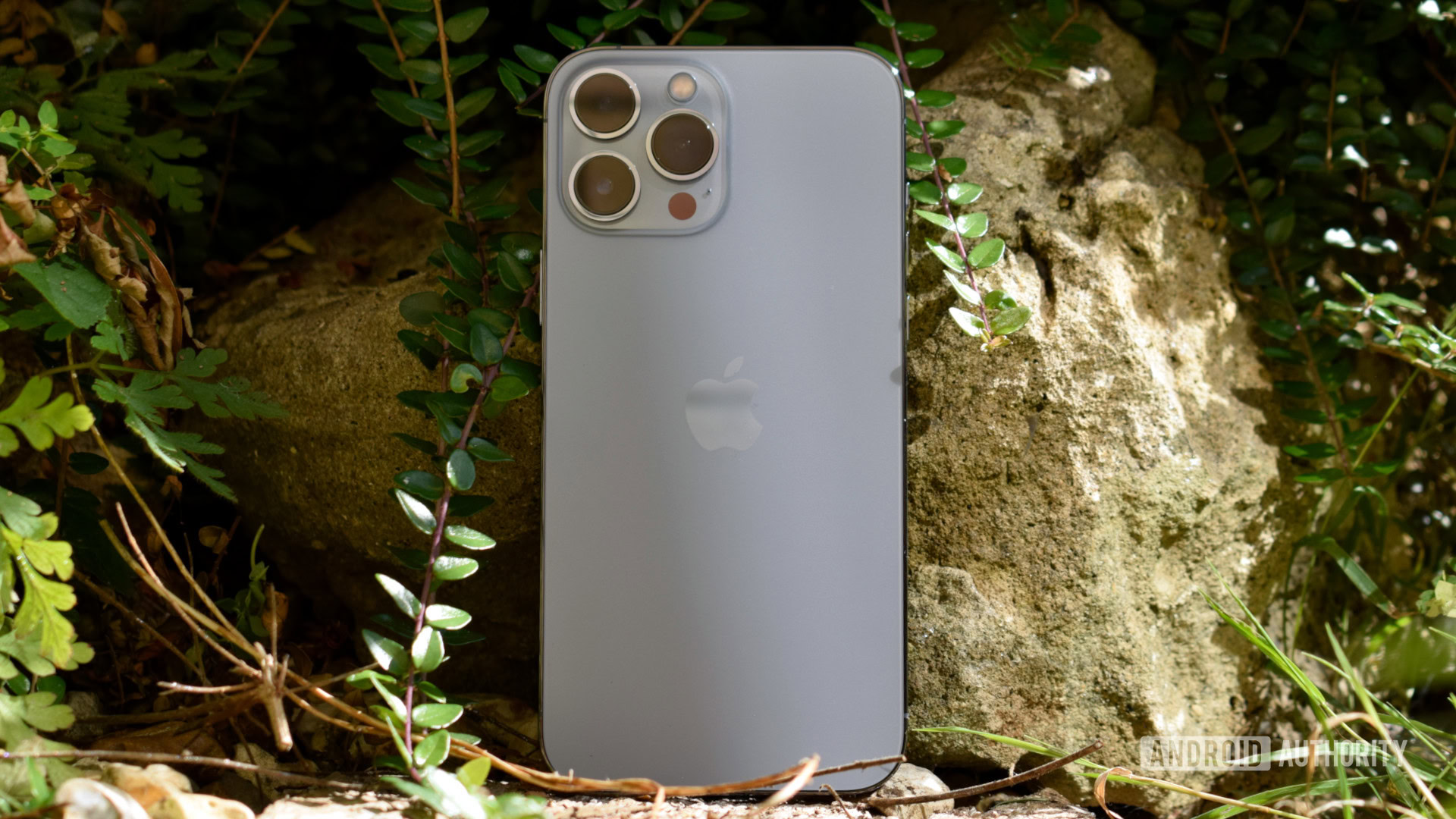
Apple receives a fair amount of criticism for a lack of innovation these days, particularly from the Android side of the smartphone coin. The iPhone 13 Pro Max certainly won’t shake the hecklers, but I’d describe Apple’s approach as staid rather than shiftless. The company knows what works and the iPhone 13 Pro Max is an unadventurous but respectable continuation of that successful formula with just enough new twists to keep it near the top of the pack.
The drawback is that Apple’s ultra-premium flagship can’t really be said to be on the cutting edge. Apple’s ProMotion display is late to the 120Hz party. The phone certainly isn’t the fastest at wired or wireless charging either. Likewise, Apple’s photography rivals are forging further ahead with long-range periscope and dual focal-length designs.
The iPhone 13 Pro Max is a respectable continuation of what Apple does best.
That said, the iPhone 13 Pro Max remains a photography, videography, and performance powerhouse. It’s a phone absent of glaring weaknesses and one that will serve even the most demanding users very well indeed. The software experience is also seamless enough to make the switch from Android without much hassle, should you be so inclined.
Whether you should upgrade is the pertinent question. With only incremental improvements on offer from the iPhone 11 to 12 and now 13 series, there’s little compelling reason to spend $1,099 on the iPhone 13 Pro Max, unless your current phone is four or more years old. Especially as Apple is rolling out iOS 15 back down the range so quickly and so comprehensively. Likewise, customers with a relatively recent Android flagship can rest assured that they’ve probably already experienced much of what Apple’s best iPhone has to offer.
Apple iPhone 13 Pro Max top questions and answers
Yes, the Apple iPhone 13 Pro Max is IP68 rated.
Yes, the Apple iPhone 13 Pro Max supports up to 15W wireless charging.
No, the Apple iPhone 13 Pro Max does not have an microSD card slot, which means you have to think carefully about which storage variant to get — you can choose between 128GB, 256GB, 512GB, and 1TB.
The main differences are that the Apple iPhone 13 Pro Max has a larger display (6.7-inch vs 6.1-inch) and a bigger battery (4,352mAh vs 3,095mAh).
There are four iPhone 13 Pro Max colors available to choose from: Graphite, Gold, Silver, and Sierra Blue.
Unfortunately, you don’t get a charger included with your Apple iPhone 13 Pro Max purchase.
Yes, the Apple iPhone 13 Pro Max supports both mmWave and sub-6GHz 5G.